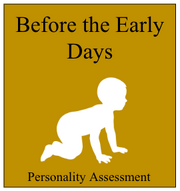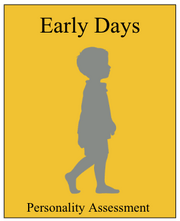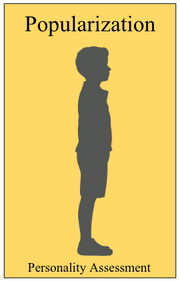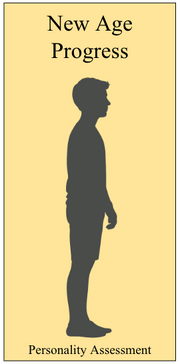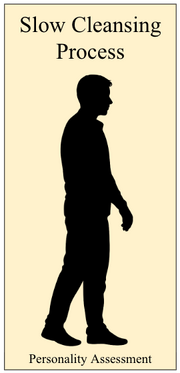Personality Assessment Story and Prospect: Difference between revisions
| (7 intermediate revisions by the same user not shown) | |||
| Line 1: | Line 1: | ||
=Introduction= | =Introduction= | ||
[[File:History 1.png|right| | [[File:History 1.png|right|180px]] | ||
Personality assessments began with modern psychology in the late 1800s to measure people's social behavior and, more broadly, their emotional states, relationships, motivations, interests, and attitudes. Since then, much has changed, making the landscape of personality assessment unrecognizable to those who started it early on. This article provides an overview of the evolution and milestones of modern personality assessments and their progress toward the “normal” range of social behaviors. It also comments on the outcomes we slowly see emerging. | Personality assessments began with modern psychology in the late 1800s to measure people's social behavior and, more broadly, their emotional states, relationships, motivations, interests, and attitudes. Since then, much has changed, making the landscape of personality assessment unrecognizable to those who started it early on, should they still be around. This article provides an overview of the evolution and milestones of modern personality assessments and their progress toward the “normal” range of social behaviors. It also comments on the outcomes we slowly see emerging. | ||
=Generalities= | =Generalities= | ||
| Line 9: | Line 9: | ||
=Early Days= | =Early Days= | ||
[[File:History 2.png|right| | [[File:History 2.png|right|180px]] | ||
Modern techniques involving questionnaires appeared at the end of the 19th century, coinciding with the development of psychiatry and the rise of statistics. Psychiatry and the emerging field of psychological science needed more effective and standardized ways to diagnose and treat clinical cases. Mathematics and physics statistics introduced new scoring methods and data analysis techniques for individuals. | Modern techniques involving questionnaires appeared at the end of the 19th century, coinciding with the development of psychiatry and the rise of statistics. Psychiatry and the emerging field of psychological science needed more effective and standardized ways to diagnose and treat clinical cases. Mathematics and physics statistics introduced new scoring methods and data analysis techniques for individuals. | ||
| Line 18: | Line 18: | ||
In the clinical field, the MMPI (Minnesota Multiphasic Personality Inventory) assessment dates back to the 1940s, originally developed by Hathaway and McKinley. It is one of the most widely used assessments for clinical applications, with around 15,000 research articles<ref>Source: University of Minnesota Press database. This figure from 2025, includes publications referencing the original MMPI as well as subsequent versions: the MMPI-A, MMPI-2, MMPI-2-RF, and MMPI-3.</ref>. The assessment was regularly revised, resulting in the MMPI-2 and the MMPI-A—a shorter version for teenagers—published in 1989. In 1948, the first version of the CPI (California Psychological Inventory) was published. This assessment was designed for “normal” populations and to be administered by psychologists. Like the MMPI, it is lengthy but is also used in education with students and for work-related applications with candidates and employees. | In the clinical field, the MMPI (Minnesota Multiphasic Personality Inventory) assessment dates back to the 1940s, originally developed by Hathaway and McKinley. It is one of the most widely used assessments for clinical applications, with around 15,000 research articles<ref>Source: University of Minnesota Press database. This figure from 2025, includes publications referencing the original MMPI as well as subsequent versions: the MMPI-A, MMPI-2, MMPI-2-RF, and MMPI-3.</ref>. The assessment was regularly revised, resulting in the MMPI-2 and the MMPI-A—a shorter version for teenagers—published in 1989. In 1948, the first version of the CPI (California Psychological Inventory) was published. This assessment was designed for “normal” populations and to be administered by psychologists. Like the MMPI, it is lengthy but is also used in education with students and for work-related applications with candidates and employees. | ||
Since their inception, influenced by psychoanalysis, other techniques called projective methods have emerged as another way to measure personality. With these, participants are exposed to stimuli such as drawings, toys, inkblots, figures, or words, and are free to express what they believe characterizes those stimuli. Two well-known projective techniques are the Rorschach (1941) and the Thematic Apperception Test (TAT) from Henry Murray (1938). These assessments are still in use today and have been regularly updated. | Since their inception, influenced by psychoanalysis, other techniques called projective methods have emerged as another way to measure personality. With these, participants are exposed to stimuli such as drawings, toys, inkblots, figures, or words, and are free to express what they believe characterizes those stimuli. Two well-known projective techniques are the Rorschach<ref>Rorschach, H. (1941). Psychodiagnostics. (Hans Huber Verlag, Transl.). Bern: Bircher. (Original work published 1921)</ref> and the Thematic Apperception Test (TAT) from Henry Murray<ref>Murray, H. A. (1938). Explorations in personality. New York: Oxford University Press</ref>. These assessments are still in use today and have been regularly updated. | ||
Interest and attitude assessments, primarily based on questionnaires, were developed alongside personality assessments. In fact, there is little distinction between the concepts of interest, attitude, and personality measured by some assessments. These concepts are often intertwined. The Strong, which originated in 1927, was revised in the 1970s and again in the 2020s, based on Holland's theory (1966). It remains one of the most popular in that category. During this early period, the development of personality assessment lagged behind that of intelligence and aptitude assessments. Statistics used to measure intelligence were first developed, and personality assessments benefited from these refinements. Personality, or at least what can be observed behaviorally, continued to evolve as a distinct concept separate from intelligence or cognitive agility. | Interest and attitude assessments, primarily based on questionnaires, were developed alongside personality assessments. In fact, there is little distinction between the concepts of interest, attitude, and personality measured by some assessments. These concepts are often intertwined. The Strong, which originated in 1927, was revised in the 1970s and again in the 2020s, based on Holland's theory<ref>Holland, J. L. (1966). The psychology of vocational choice. Waltham, MA: Blaisdell.</ref>. It remains one of the most popular in that category. During this early period, the development of personality assessment lagged behind that of intelligence and aptitude assessments. Statistics used to measure intelligence were first developed, and personality assessments benefited from these refinements. Personality, or at least what can be observed behaviorally, continued to evolve as a distinct concept separate from intelligence or cognitive agility. | ||
=Popularization= | =Popularization= | ||
[[File:History 3.png|right| | [[File:History 3.png|right|180px]] | ||
Shorter personality assessments, created by independent publishers and consulting firms rather than in academia, and intended for use by non-psychologists, started to emerge after World War II | Shorter personality assessments, created by independent publishers and consulting firms rather than in academia, and intended for use by non-psychologists, started to emerge after World War II. Despite ongoing controversies about the personality concept and its ups and downs in academia (is it truly stable? What role does the environment play?), interest in personality assessment continued to grow among the public and organizations, eventually becoming a more objective technique than the parallel, formal, and semi-formal techniques used in organizations<ref>[[ Assessment_Techniques | See here an introduction to assessment techniques.]]</ref>. | ||
Among these techniques, precursors include the AVA ( | Among these techniques, precursors include the AVA<ref>Clarke W. V. (1956). The Construction of an Industrial Selection Personality Test. The Journal of Psychology. 41, p. 379-394.</ref> and the Enneagram (1958). The MBTI, developed by Myers and Briggs from Jung's typology, emerged during the same period. Other traditional techniques for assessing traits continued to evolve and were primarily used in organizations for mass recruitment or for roles requiring special attention, such as security, forensics, the military, or top executives, often by industrial and clinical psychologists. | ||
Increased computing power in the 1980s, along with new programming languages and statistical software like SPSS, enabled the application of factor analysis on larger, more diverse samples—something previous precursors could not have envisioned. This advancement led to new discoveries in assessment techniques and personality dimensions. | Increased computing power in the 1980s, along with new programming languages and statistical software like SPSS, enabled the application of factor analysis on larger, more diverse samples—something previous precursors could not have envisioned. This advancement led to new discoveries in assessment techniques and personality dimensions. | ||
| Line 37: | Line 37: | ||
=New Age Progress= | =New Age Progress= | ||
[[File:History 4.png|right| | [[File:History 4.png|right|180px]] | ||
Since the 1990s, various non-clinical and short assessments continued to emerge. The advent of the Internet not only simplified how samples of people and statistics could be used to create new assessments but also made assessments easily accessible on laptops, tablets, and phones. Previously, people had to visit assessment centers and complete paper questionnaires with a pencil. These questionnaires needed to be scored manually, although in some cases, scoring could be automated, as with the SAT or GMAT tests used by students. With the Internet, anyone, anywhere, with minimal effort, a keyboard, and a browser connection, could complete a questionnaire on their own. Assessments that were once only found in magazines were then available online. The CliftonStrengths assessment, well known in the USA and published and distributed by Gallup, was developed in the late 1990s and has gained popularity ever since. Other similar and popular methods, such as those based on DISC or the Enneagram, continued to grow in popularity. | Since the 1990s, various non-clinical and short assessments continued to emerge. The advent of the Internet not only simplified how samples of people and statistics could be used to create new assessments but also made assessments easily accessible on laptops, tablets, and phones. Previously, people had to visit assessment centers and complete paper questionnaires with a pencil. These questionnaires needed to be scored manually, although in some cases, scoring could be automated, as with the SAT or GMAT tests used by students. With the Internet, anyone, anywhere, with minimal effort, a keyboard, and a browser connection, could complete a questionnaire on their own. Assessments that were once only found in magazines were then available online. The CliftonStrengths assessment, well known in the USA and published and distributed by Gallup, was developed in the late 1990s and has gained popularity ever since. Other similar and popular methods, such as those based on DISC or the Enneagram, continued to grow in popularity. | ||
| Line 45: | Line 45: | ||
=Slow Cleansing Process= | =Slow Cleansing Process= | ||
[[File:History 5.png|right| | [[File:History 5.png|right|180px]] | ||
We see progress in industries other than personality assessment, such as computers or automotive, where new technologies quickly replace old ones. These old technologies become obsolete, but new ones, even if recent, may soon be outdated as well. This process isn't the same with assessment techniques. The concepts and methods used to assess them gradually evolve. Old concepts and techniques can still be useful, and they’re not fully replaced by new ones. Who you learned those techniques from, the literature about them, the success stories you’ve heard, and your own positive experiences all make replacing them difficult. There is an emotional attachment to those concepts and techniques. | We see progress in industries other than personality assessment, such as computers or automotive, where new technologies quickly replace old ones. These old technologies become obsolete, but new ones, even if recent, may soon be outdated as well. This process isn't the same with assessment techniques. The concepts and methods used to assess them gradually evolve. Old concepts and techniques can still be useful, and they’re not fully replaced by new ones. Who you learned those techniques from, the literature about them, the success stories you’ve heard, and your own positive experiences all make replacing them difficult. There is an emotional attachment to those concepts and techniques. | ||
Latest revision as of 22:44, 30 September 2025
Introduction
Personality assessments began with modern psychology in the late 1800s to measure people's social behavior and, more broadly, their emotional states, relationships, motivations, interests, and attitudes. Since then, much has changed, making the landscape of personality assessment unrecognizable to those who started it early on, should they still be around. This article provides an overview of the evolution and milestones of modern personality assessments and their progress toward the “normal” range of social behaviors. It also comments on the outcomes we slowly see emerging.
Generalities
While some definitions of "personality" refer to a person’s entire character, its assessment usually concentrates on the affective, behavioral, and cognitive aspects—three interconnected dimensions that do not include intelligence, also referred to as general mental abilities (GMA), along with other dimensions like values, competencies, and skills. Over time, personality assessment has shifted toward mainly observing a person’s behavior, moving away from its original focus in psychiatry and clinical psychology. It has gradually become a way to measure people’s “normal" characteristics, rather than concentrating on pathological or “abnormal" aspects.
Its evolution has also gradually progressed in line with the concepts that academic research and the market have emphasized, beginning with behavior and, around the same period, focusing on the psyche and psychoanalysis. Later, the focus moved to cognition, and more recently, to emotions and empathy. Research in psychology, sociology, and organization has been greatly influenced by major advancements in statistics, computing capabilities, the Internet since around 1900, and more recently, Artificial Intelligence (AI). Early discoveries that still impact modern personality assessments continue to be affected by new technologies. Since our research at GRI has concentrated on assessment techniques for over 20 years, it has become clear that, compared to other fields, the progress within our domain is slow. Additionally, many aspects that remain influential today—though obviously outdated to experts—can only be understood and justified through their historical context.
Early Days
Modern techniques involving questionnaires appeared at the end of the 19th century, coinciding with the development of psychiatry and the rise of statistics. Psychiatry and the emerging field of psychological science needed more effective and standardized ways to diagnose and treat clinical cases. Mathematics and physics statistics introduced new scoring methods and data analysis techniques for individuals.
A precursor assessment used in psychiatry was developed by Emil Kraepelin at the end of the 19th century, in which participants were shown words and asked to associate another word that spontaneously came to mind. Kraepelin used this technique to study the psychological effects of fatigue, hunger, and drugs, concluding that they increased the relative frequency of certain associations. The work of Galton and Pearson emerged from the same period, although with different assessment techniques, and was later adopted by others to create the first personality assessments. The prototype of personality tests, questionnaires, or self-assessment inventories is the PDS (Personal Data Sheet), developed by Woodworth during World War I. This assessment aimed to exclude individuals with severe psychiatric disorders from military service. Although the PDS was not ready in time for wartime use, adaptations outside the military were created for special purposes such as assessments in schools, emotional adjustment evaluations, and career counseling. Some assessments focused on narrow behavioral patterns, such as submission or dominance in interpersonal contact situations.
From the 1920s and especially around the 1950s, the rate of publishing new personality assessments increased significantly. In the 1930s, Guilford and Guilford[1] applied Thurstone's factor analysis method[2] to create an assessment that initially included 36 items, later expanding to 89 items[3]. Between 1944 and 1948, Cattell worked on developing the 16 PF, which remained one of the most popular personality assessment[4] until the 1990s. Cattell’s work drew on the contributions of others, including Allport and Odberg[5] and Thurstone[6].
In the clinical field, the MMPI (Minnesota Multiphasic Personality Inventory) assessment dates back to the 1940s, originally developed by Hathaway and McKinley. It is one of the most widely used assessments for clinical applications, with around 15,000 research articles[7]. The assessment was regularly revised, resulting in the MMPI-2 and the MMPI-A—a shorter version for teenagers—published in 1989. In 1948, the first version of the CPI (California Psychological Inventory) was published. This assessment was designed for “normal” populations and to be administered by psychologists. Like the MMPI, it is lengthy but is also used in education with students and for work-related applications with candidates and employees.
Since their inception, influenced by psychoanalysis, other techniques called projective methods have emerged as another way to measure personality. With these, participants are exposed to stimuli such as drawings, toys, inkblots, figures, or words, and are free to express what they believe characterizes those stimuli. Two well-known projective techniques are the Rorschach[8] and the Thematic Apperception Test (TAT) from Henry Murray[9]. These assessments are still in use today and have been regularly updated.
Interest and attitude assessments, primarily based on questionnaires, were developed alongside personality assessments. In fact, there is little distinction between the concepts of interest, attitude, and personality measured by some assessments. These concepts are often intertwined. The Strong, which originated in 1927, was revised in the 1970s and again in the 2020s, based on Holland's theory[10]. It remains one of the most popular in that category. During this early period, the development of personality assessment lagged behind that of intelligence and aptitude assessments. Statistics used to measure intelligence were first developed, and personality assessments benefited from these refinements. Personality, or at least what can be observed behaviorally, continued to evolve as a distinct concept separate from intelligence or cognitive agility.
Popularization
Shorter personality assessments, created by independent publishers and consulting firms rather than in academia, and intended for use by non-psychologists, started to emerge after World War II. Despite ongoing controversies about the personality concept and its ups and downs in academia (is it truly stable? What role does the environment play?), interest in personality assessment continued to grow among the public and organizations, eventually becoming a more objective technique than the parallel, formal, and semi-formal techniques used in organizations[11].
Among these techniques, precursors include the AVA[12] and the Enneagram (1958). The MBTI, developed by Myers and Briggs from Jung's typology, emerged during the same period. Other traditional techniques for assessing traits continued to evolve and were primarily used in organizations for mass recruitment or for roles requiring special attention, such as security, forensics, the military, or top executives, often by industrial and clinical psychologists.
Increased computing power in the 1980s, along with new programming languages and statistical software like SPSS, enabled the application of factor analysis on larger, more diverse samples—something previous precursors could not have envisioned. This advancement led to new discoveries in assessment techniques and personality dimensions.
The number of traits measurable with personality assessments kept increasing during this period. Meanwhile, factor analysis focused on personality dimensions. Well-researched techniques like the 16PF were leading to a smaller, more straightforward number of dimensions needed to describe personality. A consensus gradually formed until the 1990s that five dimensions, plus or minus two, were sufficient. This means that anywhere from three to seven dimensions can effectively describe most personality traits related to behavior.
Although its growth was slow at first, the Myers-Briggs Type Indicator (MBTI) gained popularity during the 1980s. Building on Jung’s theory and with persistent efforts from its creators, coupled with markets increasingly seeking solutions for personal issues, the MBTI found its way into companies. Although it differs from the personality assessments used in recruitment and was not initially promoted for that purpose, the MBTI expanded through consultant networks—at a time when coaching had yet to become widespread. Simpler techniques than those of the early period, which focused more on the “normal” personality aspects, continued to gain popularity during this time. For example, the DISC technique, introduced under different names and in various versions starting in the early 1950s, and the Enneagram.
Much research into personality assessment and commercialized techniques emerged from the USA. During this period of popularization, translations into languages other than English became available, and the adaptation of norms and scales between countries became more affordable thanks to computers. Other countries adopted and were inspired to develop their own local or improved versions of early techniques. For instance, DISC gained popularity in Brazil, and MBTI gained traction in France, where psychoanalysis and Jungian theory already had a large audience. Legal standards such as EEOC and ADA compliance in the USA were established during this time, and similar norms were adopted in other countries.
New Age Progress
Since the 1990s, various non-clinical and short assessments continued to emerge. The advent of the Internet not only simplified how samples of people and statistics could be used to create new assessments but also made assessments easily accessible on laptops, tablets, and phones. Previously, people had to visit assessment centers and complete paper questionnaires with a pencil. These questionnaires needed to be scored manually, although in some cases, scoring could be automated, as with the SAT or GMAT tests used by students. With the Internet, anyone, anywhere, with minimal effort, a keyboard, and a browser connection, could complete a questionnaire on their own. Assessments that were once only found in magazines were then available online. The CliftonStrengths assessment, well known in the USA and published and distributed by Gallup, was developed in the late 1990s and has gained popularity ever since. Other similar and popular methods, such as those based on DISC or the Enneagram, continued to grow in popularity.
Research on personality dimensions using factor analysis dates back to the 1930s. Thanks to discoveries from earlier decades and intensified research in the 1990s, the Five Factor Model (FFM) of personality became the standard among psychologists for research purposes. These discoveries also influenced assessments from previous generations, where a smaller number of dimensions makes more sense than measuring every new personality concept that the market promotes. The number of assessments available today continues to grow daily, with new techniques that increasingly resemble each other or are marketed as improved versions of popular ones, often at a better price or with different learning and deployment options. AI now has access to more information to quickly create new, specific assessments on demand
Information shared online by users, publishers, distributors, and Wikipedia about personality assessments helps accelerate understanding of how modern techniques can explore the aspects of personality related to emotional and cognitive differences among humans. Although numerous systems come and go, creating a sense of chaos and negatively affecting the credibility of these systems, progress remains slow. Nonetheless, consensus on their potential and value gradually emerges.
Slow Cleansing Process
We see progress in industries other than personality assessment, such as computers or automotive, where new technologies quickly replace old ones. These old technologies become obsolete, but new ones, even if recent, may soon be outdated as well. This process isn't the same with assessment techniques. The concepts and methods used to assess them gradually evolve. Old concepts and techniques can still be useful, and they’re not fully replaced by new ones. Who you learned those techniques from, the literature about them, the success stories you’ve heard, and your own positive experiences all make replacing them difficult. There is an emotional attachment to those concepts and techniques.
Esoteric techniques may be intriguing and fun to discuss casually with friends. Some people see benefits in them, which explains the $15 billion astrology market in 2025. For business purposes, propositions based on esoteric techniques are often misleading, ineffective, and counterproductive.
The same is true for modern assessment techniques to which people become emotionally attached, for the same reasons others become attached to their own private or esoteric techniques. Shifting from one assessment method to another involves a trial-and-error process. Testing a new method, understanding its capabilities and limitations, and gaining trust in it can take time.
Determining that an assessment technique is scientific because some statistics support it is not enough. What makes an assessment technique more valuable is its ability to reduce uncertainty, help make better-informed decisions, and foster attitudes that can lead to improved outcomes—such as avoiding unproductive conflicts, enhancing communication, and making better-quality hires. These outcomes are easy to track with KPIs.
Improved outcomes over time, achieved through repeated observations that the new technique consistently delivers better results than the soon-to-be-replaced methods, illustrate how one technique gradually takes over another. Once again, the techniques in competition are not limited to statistics-based assessments alone, but also include private, common, and esoteric techniques that will never be fully replaced.
Revealing the Unseen
Modern assessment techniques can collect information from participants' experiences that would be difficult to obtain otherwise. They ask participants standardized questions. They also allow the use of statistics that we wouldn’t be able to perform ourselves, such as calculating averages, standard deviations, and making comparisons between large samples. Even with years of experience and many encounters, we couldn’t possibly do those statistics on our own. The observation above doesn’t mean that all assessment techniques are equally useful. The specific concepts being assessed, how they are assessed, learned, and used for particular purposes make a big difference. Statistics are important; they are necessary for designing an assessment. They are also essential for providing a deeper understanding of the quality of what is assessed. Statistics and quality approaches work together and complement each other.
Over time, assessment techniques progressively shifted from the hands of storytellers and experts to those of psychiatrists, then experts formally trained in clinical and industrial psychology, and ultimately into the hands of recruiters, consultants, and coaches. They have remained in the hands of intermediaries, not their end users, while simultaneously leaving the realm of esoterism and therapy to enter the world of normalcy.
Where modern assessment stands today is knowledge that includes subtle details and improvements invisible to the eye, which individuals can use to significantly improve their private techniques.
Notes
- ↑ Guilford, J. P., & Guilford, R. B. (1936). Personality factors S, E, and M, and their measurement. Journal of Personality, 34, 21-36.
- ↑ Thurstone L. L. (1934). The Vectors of Mind. Psychological Review, Vol. 41, p. 1-32.
- ↑ Guilford, J. P., & Guilford, R. B. (1939). Personality factors D, R, T and A. Journal of Abnormal and Social Psychology, 34, 239-248.
- ↑ Catell, R. B. (1947). Confirmation and clarification of the primary personality factors. Psychometrika, 12, 197-220.
- ↑ Allport G. W., Odbert H. S. (1936). Trait names: A psycho-lexical study. Psychological Monographs, 47 (1, tout No. 211).
- ↑ Ibid, Thurstone, 1934.
- ↑ Source: University of Minnesota Press database. This figure from 2025, includes publications referencing the original MMPI as well as subsequent versions: the MMPI-A, MMPI-2, MMPI-2-RF, and MMPI-3.
- ↑ Rorschach, H. (1941). Psychodiagnostics. (Hans Huber Verlag, Transl.). Bern: Bircher. (Original work published 1921)
- ↑ Murray, H. A. (1938). Explorations in personality. New York: Oxford University Press
- ↑ Holland, J. L. (1966). The psychology of vocational choice. Waltham, MA: Blaisdell.
- ↑ See here an introduction to assessment techniques.
- ↑ Clarke W. V. (1956). The Construction of an Industrial Selection Personality Test. The Journal of Psychology. 41, p. 379-394.

